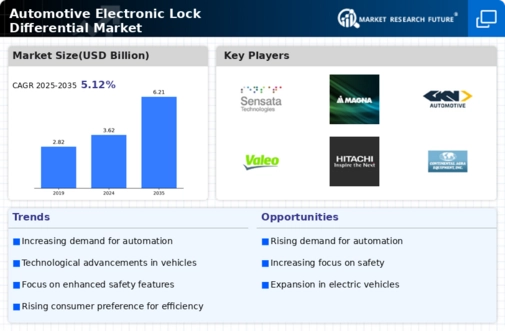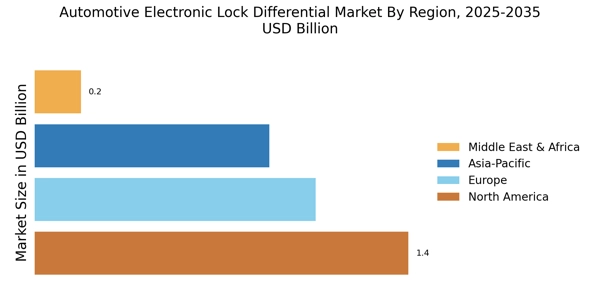Growth in Electric Vehicle Adoption
The Automotive Electronic Lock Differential Market is poised for growth due to the rising adoption of electric vehicles (EVs). As the automotive landscape shifts towards electrification, the need for efficient power distribution becomes paramount. Electronic lock differentials play a crucial role in optimizing torque delivery to the wheels, enhancing the overall driving experience. Recent statistics indicate that the EV market is projected to grow at a compound annual growth rate of 25% over the next five years. This growth is likely to drive demand for advanced differential technologies, positioning electronic lock differentials as a key component in the evolution of electric drivetrains.
Rising Demand for Advanced Safety Features
The Automotive Electronic Lock Differential Market is experiencing a surge in demand for advanced safety features in vehicles. As consumers become increasingly aware of safety standards, manufacturers are integrating electronic lock differentials to enhance vehicle stability and control. This technology allows for better traction and handling, particularly in adverse weather conditions. According to recent data, vehicles equipped with electronic lock differentials have shown a 20% improvement in stability during cornering maneuvers. This trend is likely to continue as safety regulations become more stringent, pushing manufacturers to adopt innovative solutions that meet consumer expectations for safety and performance.
Increased Focus on Performance and Handling
The Automotive Electronic Lock Differential Market is significantly influenced by the growing consumer focus on vehicle performance and handling. Enthusiasts and everyday drivers alike are seeking vehicles that offer superior driving dynamics. Electronic lock differentials provide enhanced cornering capabilities and improved traction, which are essential for performance-oriented vehicles. Market analysis suggests that vehicles equipped with these differentials can achieve a 15% increase in cornering speed compared to traditional systems. As manufacturers strive to meet these performance demands, the integration of electronic lock differentials is likely to become a standard feature in high-performance models.
Regulatory Push for Enhanced Vehicle Efficiency
The Automotive Electronic Lock Differential Market is also shaped by regulatory pressures aimed at enhancing vehicle efficiency. Governments worldwide are implementing stricter emissions standards, prompting manufacturers to seek technologies that improve fuel economy. Electronic lock differentials contribute to this goal by optimizing power delivery and reducing energy losses during operation. Recent reports suggest that vehicles utilizing electronic lock differentials can achieve up to a 10% improvement in fuel efficiency. As regulations become more stringent, the adoption of electronic lock differentials is likely to increase, positioning them as a vital component in the quest for more efficient vehicles.
Technological Innovations in Automotive Engineering
The Automotive Electronic Lock Differential Market is benefiting from rapid technological innovations in automotive engineering. Advancements in sensor technology and control algorithms have enabled the development of more sophisticated electronic lock differentials. These innovations allow for real-time adjustments to torque distribution, enhancing vehicle stability and performance. Data indicates that the integration of such technologies can lead to a 30% reduction in wheel slip during acceleration. As automotive manufacturers continue to invest in research and development, the market for electronic lock differentials is expected to expand, driven by the demand for cutting-edge engineering solutions.


















Leave a Comment